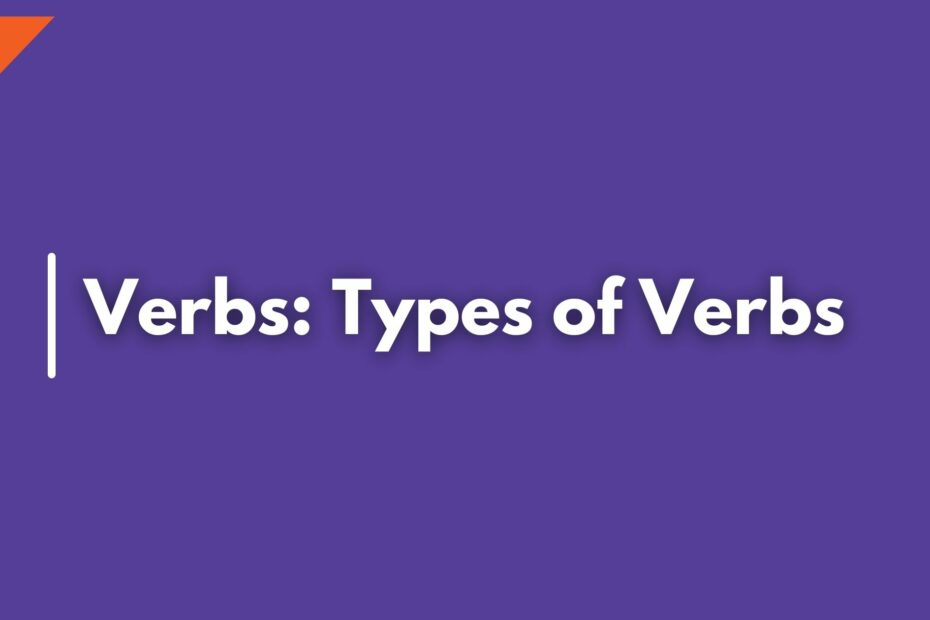Verbs are one of the most important parts of speech in the English language. They are used to describe actions, states, and occurrences, and can be conjugated to express different tenses. For example, write, run, go, read, etc. Mastering the use of verbs is essential for becoming a proficient English speaker. In this article, you will learn the 8 types of verbs.
Some examples of verbs:
- He played hockey. (action)
- He is laughing. (state)
- It rained yesterday (occurrence).
- It snowed a lot that winter (event),
- I wrote a story. (action)
- He appears satisfied, (state)
Understanding the 8 Types of verbs
There are 8 types of verbs in the English language: action verbs, linking verbs, auxiliary verbs, modal verbs, incomplete verbs, finite Verbs, infinite Verbs, and, non-finite.
1. Action verbs
Action verbs are just what they sound like: words that describe an action. They can be physical actions, like “run,” “jump,” or “swim.” They can also describe mental actions, like “think,” “believe,” or “remember.” Regardless of the type of action, action verbs are always used to describe an active process. One important thing to remember about action verbs is that they are always in the present tense.
Examples:
- Authors write book reviews for newspapers.
- Novelists earn a living from their books.
- Some reporters now use word processors.
The classification of the action verbs depends on how they appear in the sentence. There are three significant categories of action verbs: transitive and intransitive verbs.
a. Transitive verbs
A verb is transitive when the sentence’s meaning passes directly from the subject through the verb into the object. Transitive verbs needed to have one or more objects to complete the purpose of the sentence—the action of the verb that makes perfect sense, called transitivity.
For example, In the sentence “ Oliver washed the car,” the car is the object that makes sense or completes the action of a transitive verb. Suppose we remove the objects from the sentence above. In that case, we left with incomplete statements: Oliver washed.
Some other examples:
- William killed the snake.
- Sophia was looking through the newspaper.
- John played the game.
b. Intransitive verbs
An intransitive verb does not transmit meaning to an object. Instead, the intransitive verb completes the purpose of the sentence without adding an object, as this example shows: Darkness fell, but the police persist. The constable protested.
More Examples:
- My cat ran.
- I can’t believe our dog died.
- Don’t be too loud. Roy sleeping.
Ran, died, and sleeping is the intransitive verb in the above three sentences.
Transitive vs. Intransitive verbs
Some intransitive verbs can be changed into transitive verbs by adding different adverbs and prepositions. For example, the intransitive verb look can be transformed into several different transitive verbs: look after or look into, look down on, look up to, look back on, look through, look forward to.
2. Linking Verbs
Linking verbs connect the subject of a sentence with a noun or adjective that describes or identifies it. They are used to describe the state of a subject, but they do not express any action. Some common linking verbs include; be, become, appear, look, feel, sound, smell, and taste. These verbs are important in creating clear and concise sentences. Without linking verbs, our writing would be choppy and difficult to understand.
Examples:
- Henry seems to be happy.
- Cora feels happy.
- The chocolate tastes good.
- This fish smells terrible.
- You are looking happy.
- I feel inconvenienced.
- Sophia appeared calm.
- Roy’s voice sounded friendly.
There are several different names for linking verbs, same as copular, copulas, and notional verbs. The following are the standard linking verbs in English.
| are being | can be | come | look |
| shall be | will be | might be | Cloud be |
| had been | has been | have been | have seemed |
| maybe | looked | seemed | keep |
| appear | indicate | remained | became |
| feel | sound | taste | got |
| acted | will become | would be | were |
| was | am | are | is |
| is being | is getting | act | fell |
| felt | sit | remain | grow |
3. Auxiliary verbs
Auxiliary verbs (also called helping verbs) help to form the tense of a verb phrase or show the degree of ability, possibility, or certainty.
An auxiliary verb is a verb that provides additional or supporting information about the main verb in a sentence. The auxiliary verbs help to show the perfect aspect along with the participle. The most common auxiliary verbs such as can, could, may, might, must, shall, should, will, and would.
Examples:
- Do you write something about me?
- Roy can drive a car.
- I am taking a coffee to release my stress.
- She has given her best in the debate.
4. Modal verbs
Modal verbs express the mode and manners in which action takes place. They do not appear as gerunds, infinitives, or participles. The standard modal verbs in English are: can, could, will, would, may, might, must, ought to, and should.
Examples of modal verbs:
- They can manage their one fund; we cannot fix it.
- Could you say it once more slowly?
- Will you go to school today?
- May I go out to play?
- You might find John in the library.
- We must say goodbye now.
- Young people ought to help the older man.
- We should sort out this problem at once.
5. Incomplete verbs
Incomplete verbs require something more than subject and object to complete the purpose of the sentence. The most common incomplete verbs are: become, look, seem, appear, smell, make, call and taste.
Examples:
- She became. (incomplete)
- She becomes happy. (complete)
- Liam appears. (incomplete)
- Liam appears in the examination. (complete)
6. Finite verbs
A finite verb is a verb that has a subject. The subject of a verb, and thus the subject of the clause or sentence in which that verb appears, is the factor responsible for the action or activity indicated by the verb:
For Example:
- Rock bands (subject)/attract (verb)/big audiences.
- You (subject)/believe (verb)/her.
- Members of the committee (subject)/consider (verb)/the planning proposal.
7. Infinitives verbs
An infinitive verb is a verb in its simplest form. It is not conjugated and is not attached to a subject. Infinitive verbs are often used as the root form of a verb, or the base form. The base form is the form of the verb that is used in dictionaries. For example, the base form of ‘walk’ is ‘to walk’.
8. Non-finite verbs
Non-finite verbs are verbs that are not inflected for person or number and do not indicate tense. There are three types of non-finite verbs: infinitives, gerunds, and participles. Non-finite verbs can function as either verbs or adjectives in a sentence.
Final Words!
In conclusion, there are 8 types of verbs: action verbs, linking verbs, auxiliary verbs, modal verbs, incomplete verbs, finite Verbs, infinite Verbs, and, non-finite. Each type of verb serves a different purpose in a sentence. When choosing a verb, it is important to select the one that most accurately describes the intended meaning.

